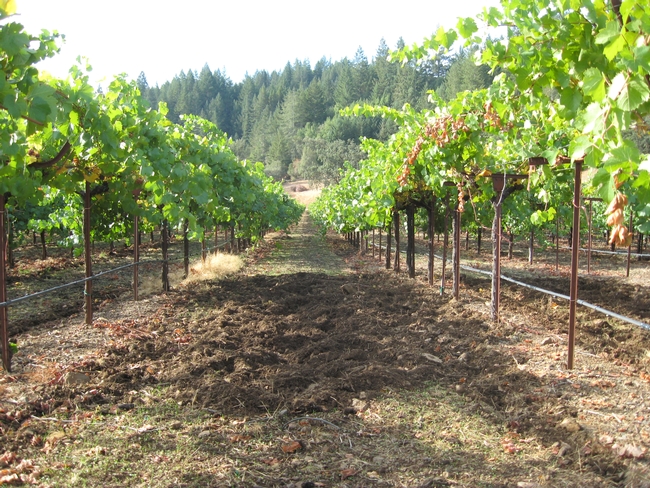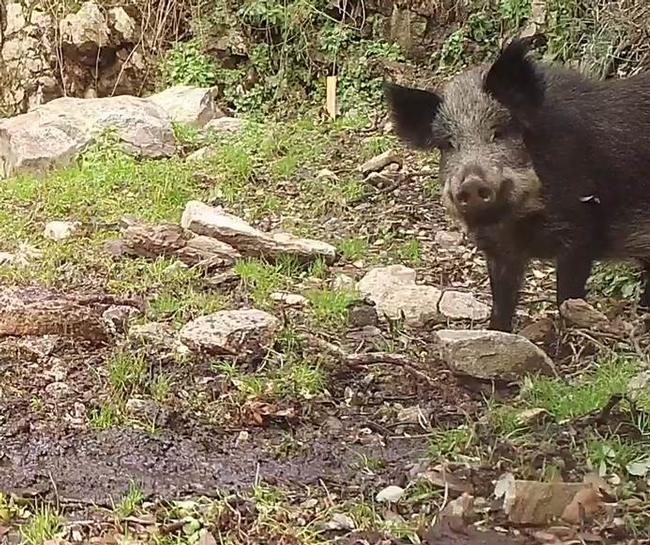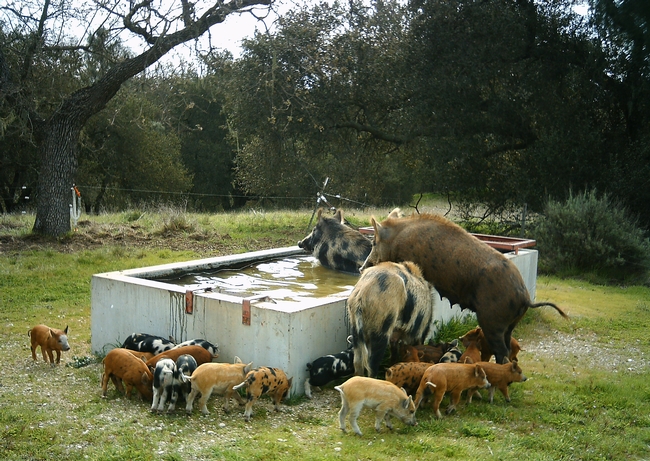
Posts Tagged: wild pigs
Invasive Spotlight: Wild Pigs
It may surprise you to learn that California is home to invasive wild pigs, also called feral hogs...
Invasive Spotlight: Wild Pigs
Domestic pigs are a familiar farm animal, but have you heard about wild pigs? These animals are...
UC Cooperative Extension to track wild pig damage
UC Cooperative Extension is asking California farmers and landowners to help track the the state's wild pig population, reported Julia Mitric on Capitol Public Radio News. Signs of the pig's presence are hard to miss, UCCE advisor John Harper told the reporter.
"It looks like you came in with a rototiller and just uprooted everything," he says. "It's like ground squirrel mounds or gopher mounds on steroids because the pigs can go over such a large area."
California's wild pigs have a variety of origins. Harper says many are descended from domestic pigs who were released into the wild by humans or escaped on their own and bred with game hogs such as the Russian boar hog. Wild pigs root around in the soil for truffles and small plant roots with their sharp tusks tear, destroying plants and grasses that sheep and cattle like to graze on. They also open up the land for erosion and invasive species.
"So you might get something like 'medusahead,' an invasive grass that tends to crowd out other more desirable forage species," Harper said.
A team of UC Cooperative Extension scientists have created a GIS-based mobile app that works on Android and Apple devices to make it easy for landowners to participate in the study.
“Rangeland managers and farmers can enter data into the app from the field so that we can estimate the land area and economic impacts of feral pig damage over a longer time period,” said Roger Baldwin, UC Cooperative Extension wildlife specialist in the Department of Wildlife, Fish, and Conservation Biology at UC Davis.
Learn more and sign up to participate in the study on the UC Agriculture and Natural Resources news website.
Citizen scientists can help track wild pigs with new UC mobile app
Whether you call them wild hogs, feral pigs, feral hogs, wild boars, Russian boars or Eurasian boars, by any name the hairy beasts are wrecking crews on California lands. In rangelands, forests and farms, wild pigs trample crops, prey on farm animals and rip up soil with their sharp tusks, contributing to erosion.

“Rangeland managers and farmers can enter data into the app from the field so that we can estimate the land area and economic impacts of feral pig damage over a longer time period,” said Roger Baldwin, UC Cooperative Extension wildlife specialist in the Department of Wildlife, Fish, and Conservation Biology at UC Davis.
Here's how it works. To file a report, users take photos of the wild pig damage, describe the damage and note the number of pigs seen. The app will map the acreage and geographic location. Cell service is not required at the site to collect data.
When the user is connected to wi-fi or cell service, the data and photos will be uploaded to the UC Agriculture and Natural Resources server so Baldwin and John Harper, UC Cooperative Extension livestock and natural resources advisor, can analyze the data. Users will be able to see a map of wild pig damage, but to maintain user privacy, private property and user identities are blocked from the general public.
"The goal of the app is to demarcate wild pig damage, ultimately allowing us to relate this data to habitat features present at damage sites to determine the impact that these habitat components have, both on how pigs use the landscape and where damage is most likely to occur,” Baldwin said.

“The app, especially from a rangeland standpoint, will provide a large data set that will help us calculate acreage damaged,” said Harper, who is based in Mendocino and Lake counties. “Once that is available, we have tools, presently used for fire loss, that will allow us to calculate economic loss of forage due to the pigs. The end user would benefit in knowing that loss and policymakers would benefit from knowing the aggregate economic loss from a managed game animal.”
Wild pig populations and their associated damage are so widespread throughout California that statewide eradication efforts may not be possible, according to Baldwin.
“We probably need to focus our limited resources on managing wild pigs in targeted areas that will provide the greatest benefit,” he said. “Information collected from this app will hopefully allow us to identify these areas, ultimately resulting in more effective and practical management of wild pigs in both agricultural and natural resource landscapes."
The wild pig damage app can be downloaded for free from the App Store and Google Play. Development of the app was funded by the Renewable Resources Extension Act, a program of USDA National Institute of Food and Agriculture.
Although the study is currently focused on California, the app could be adapted to work at a regional, national or international scale. Citizen scientists can also use the app to report wild pig damage they see around the state.
To participate in the wild pig damage project without the app, landowners and ranchers can fill out a short survey at http://ucanr.edu/wildpig2016.
The survey takes about 15 minutes to complete. Individual identities and survey responses will be kept confidential and participation in the survey is entirely voluntary.
Got wild pigs? UC Cooperative Extension wants to hear from you
Wild pigs can spread disease to people, pets and livestock. Leptospirosis, tuberculosis and brucellosis are among more than 30 diseases that wild pigs can spread to humans and livestock. The feral pig species can damage forage and crops and contribute to erosion, which can affect water quality and allow invasive plant species to establish. The boorish boars can also prey on livestock, harassing, injuring or even killing cows, goats, sheep, horses and other animals.
Although anecdotal evidence of wild pig damage has been shared by landowners and farmers, official estimates of porcine damage occurring on agricultural lands are not well defined and are highly variable. To get a more accurate picture of the wild pig problem in California, UC Cooperative Extension is conducting a survey of landowners and ranchers statewide.
“The geographical extent of wild pig damage in California is currently unknown, making it difficult to mitigate and manage losses, and hard to estimate the economic impact on private landowners and public lands,” said John Harper, UC Cooperative Extension livestock and natural resources advisor in Mendocino and Lake counties.
To complement the survey, Harper and Roger Baldwin, UC Cooperative Extension wildlife specialist in the Department of Wildlife, Fish, and Conservation Biology at UC Davis, have developed a smartphone and mobile app that will help landowners and managers identify and record feral pig damage.
“Rangeland managers and farmers can enter data into the app from the field so that we can estimate the land area and economic impacts of feral pig damage over a longer time period,” said Baldwin. “Farmers and landowners who are interested in participating in data collection using our mobile application should fill out the survey and indicate their interest in the app at the end of the survey.”
To participate in the wild pig damage project, landowners and ranchers can fill out a short survey at http://ucanr.edu/wildpig2016.
The survey takes about 15 minutes to complete. Individual identities and survey responses will be kept confidential and participation in the survey is entirely voluntary.
Although wild pigs can be a nuisance in residential areas, this project is currently designed to assess the situation in rural settings.
For more information about the wild pig damage project or to obtain a paper copy of the survey, please contact Harper at (707) 463-4495 or jmharper@ucanr.edu or Baldwin at (530) 752-4551 or rabaldwin@ucdavis.edu.





